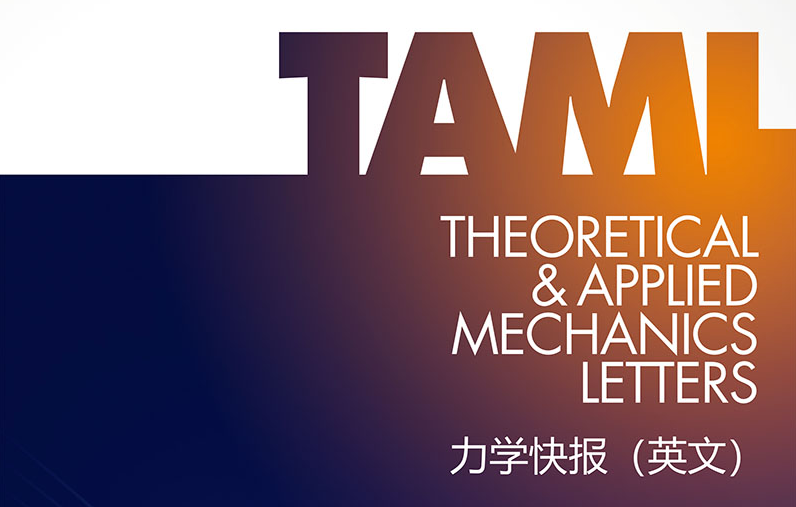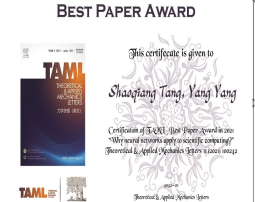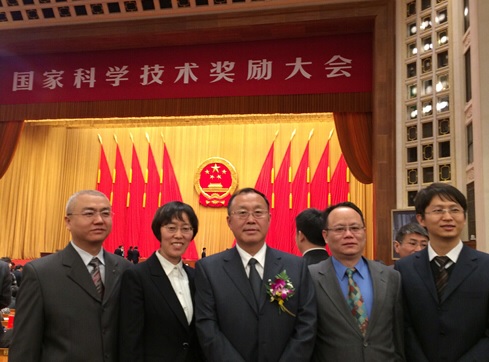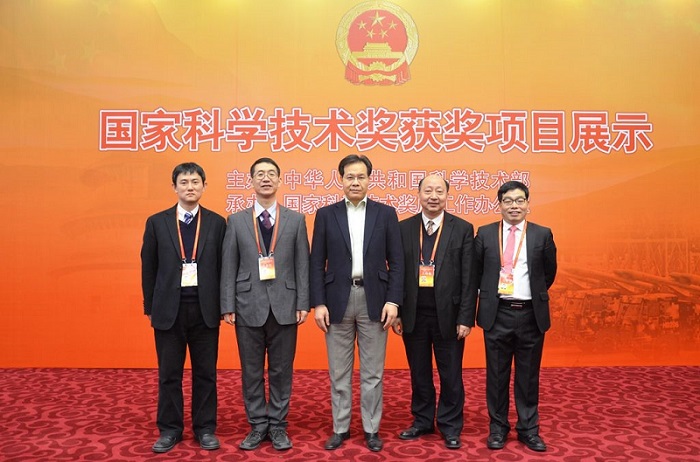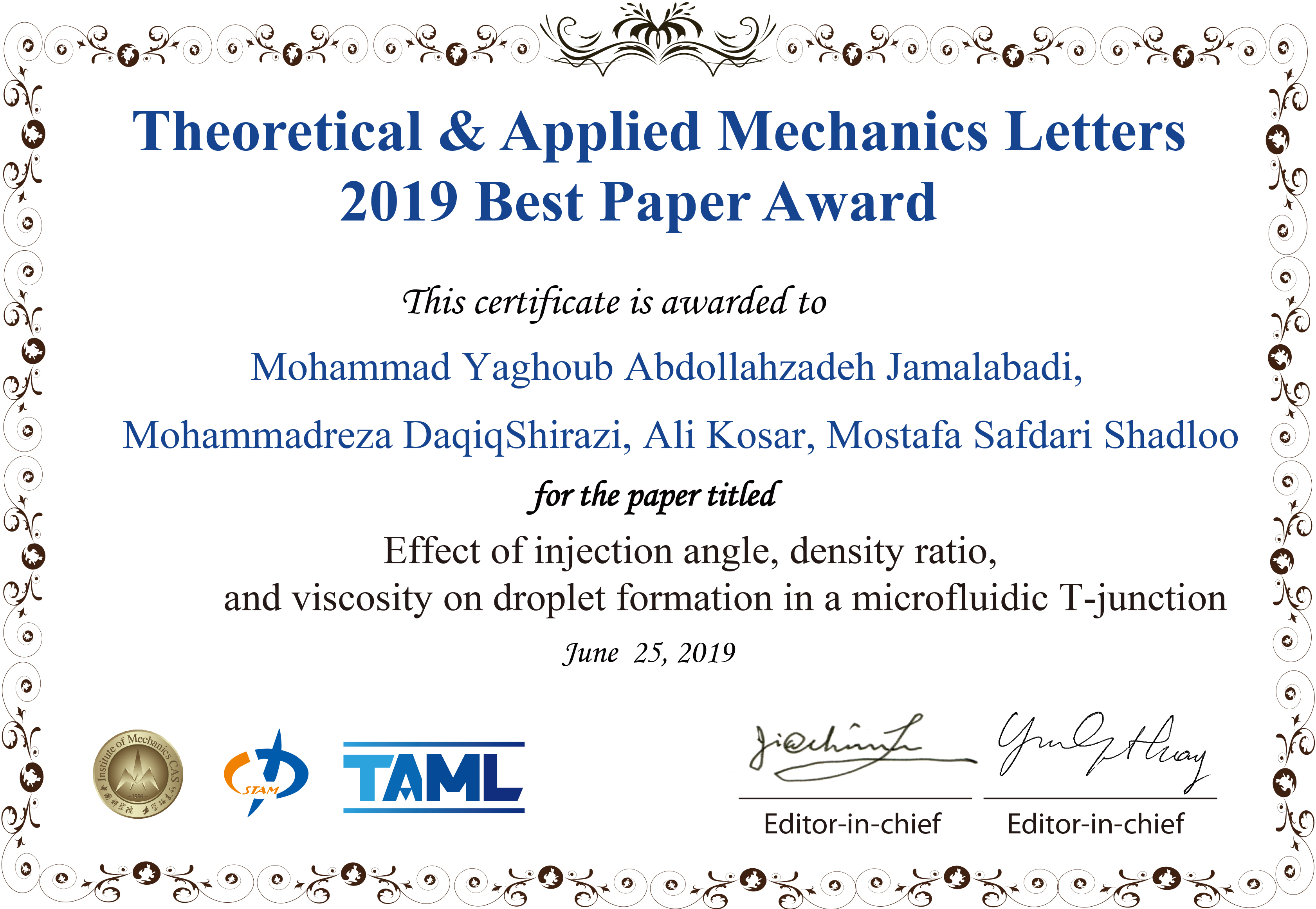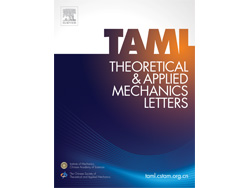Institute of Mechanics,
Chinese Academy of Sciences
2022 Vol.12(5)
Display Mode: |
Theoretical and Applied Mechanics Letters 12 (2022) 100355.
doi: 10.1016/j.taml.2022.100355
Abstract:
Holding an object by clamping force is a fundamental process for functional structures in natural and manmade systems.Examples encompass different applications as shown in Fig.1,such as,medical clips,glass frame,hairband,headphone as well as robots[1-3]
Holding an object by clamping force is a fundamental process for functional structures in natural and manmade systems.Examples encompass different applications as shown in Fig.1,such as,medical clips,glass frame,hairband,headphone as well as robots[1-3]
Theoretical and Applied Mechanics Letters 12 (2022) 100357.
doi: 10.1016/j.taml.2022.100357
Abstract:
Hybrid nanofluids have attracted burgeoning attention owing to their outstanding capacity to improve heat transfer.The influence of velocity and temperature slip parameter and Nanoparticls'(NPs') volume fraction on a vertical plate in the existence of suction has been explored in this work.The investigation's controlling partial differentiation equations were transformed into a conventional differential equation mechanism using resemblance modifications.Equations were then solved employing the fifth-order Runge-Kutta method.The skin coefficient of friction,temperature,and temperature gradient all rise when the volume percentage of NPs increases from 0 to 2%.Furthermore,a rise in the temperature slip variable was linked to a drop in the Nusselt number (heat transfer).The Nusselt number increased 0.15% and 5.63% respectively when the velocity slip parameter enhanced from 0 to 5 and the NPs volume percentage were increased from 0 to 1.5%.Furthermore,an increase in the temperature slip from 0 to 3 inflated the x-direction skin friction coefficient 8.2%,while inflation in the velocity slip from 0 to 5 was associated with a decline in the x-direction skin friction coefficient 95%.
Hybrid nanofluids have attracted burgeoning attention owing to their outstanding capacity to improve heat transfer.The influence of velocity and temperature slip parameter and Nanoparticls'(NPs') volume fraction on a vertical plate in the existence of suction has been explored in this work.The investigation's controlling partial differentiation equations were transformed into a conventional differential equation mechanism using resemblance modifications.Equations were then solved employing the fifth-order Runge-Kutta method.The skin coefficient of friction,temperature,and temperature gradient all rise when the volume percentage of NPs increases from 0 to 2%.Furthermore,a rise in the temperature slip variable was linked to a drop in the Nusselt number (heat transfer).The Nusselt number increased 0.15% and 5.63% respectively when the velocity slip parameter enhanced from 0 to 5 and the NPs volume percentage were increased from 0 to 1.5%.Furthermore,an increase in the temperature slip from 0 to 3 inflated the x-direction skin friction coefficient 8.2%,while inflation in the velocity slip from 0 to 5 was associated with a decline in the x-direction skin friction coefficient 95%.
Theoretical and Applied Mechanics Letters 12 (2022) 100362.
doi: 10.1016/j.taml.2022.100362
Abstract:
The Navier-Stokes equations are nonlinear partial differential equations (PDEs) describing viscous fluid flow,which are applicable to various scientific and engineering flow problems,such as river flow,air flow around wings,ocean currents,blood flow in the human cardiovascular system,etc.The solution of the NavierStokes equations is of great significance in the field of fluid mechanics.The convection term leads to the high nonlinearity of Navier-Stokes equations,and the solutions contain multi-scale flow structures.Nowadays,the numerical method is still a workhorse tool for solving complex flow phenomena.Thanks to the rapid growth of computer computing power and speed,the computational fluid dynamics (CFD) has made great progress[1-4].For incompressible Navier-Stokes equations,the main difficulty of numerical solution lies in the treatment of pressure,that is,how to deal with the coupling between velocity and pressure under incompressible constraints.To overcome this difficulty,Chorin[5]proposed the projection method (or fractional step method),which is widely used for its skillfully decoupling of the velocity and pressure fields.In the projection method,an incomplete form of momentum equations is first solved to obtain an intermediate velocity field,which is usually not divergence-free,then the velocity field is projected into the divergence-free field without changing the vorticity.This projection step is achieved by solving the pressure Poisson equation (PPE) and is usually more timeconsuming and computationally expensive than other steps in the overall solution process.
The Navier-Stokes equations are nonlinear partial differential equations (PDEs) describing viscous fluid flow,which are applicable to various scientific and engineering flow problems,such as river flow,air flow around wings,ocean currents,blood flow in the human cardiovascular system,etc.The solution of the NavierStokes equations is of great significance in the field of fluid mechanics.The convection term leads to the high nonlinearity of Navier-Stokes equations,and the solutions contain multi-scale flow structures.Nowadays,the numerical method is still a workhorse tool for solving complex flow phenomena.Thanks to the rapid growth of computer computing power and speed,the computational fluid dynamics (CFD) has made great progress[1-4].For incompressible Navier-Stokes equations,the main difficulty of numerical solution lies in the treatment of pressure,that is,how to deal with the coupling between velocity and pressure under incompressible constraints.To overcome this difficulty,Chorin[5]proposed the projection method (or fractional step method),which is widely used for its skillfully decoupling of the velocity and pressure fields.In the projection method,an incomplete form of momentum equations is first solved to obtain an intermediate velocity field,which is usually not divergence-free,then the velocity field is projected into the divergence-free field without changing the vorticity.This projection step is achieved by solving the pressure Poisson equation (PPE) and is usually more timeconsuming and computationally expensive than other steps in the overall solution process.
Theoretical and Applied Mechanics Letters 12 (2022) 100364.
doi: 10.1016/j.taml.2022.100364
Abstract:
Excessive vibrations,such as those stimulated by strong wind and severe earthquake,tend to reduce the comfort of user,shorten structure lifespan,and in extreme cases lead to structural failure or even large number of casualties[1].The attachment of nonlinear energy sink (NES) induces targeted energy transfer (TET) in an irreversible manner,thus effectively attenuating undesirable vibration[2,3].Among various forms of NES,employing the nonsmooth nonlinear element in NES which is termed as vibro-impact NES (VI-NES)[4,5].The competence of VI-NES in reducing structural response has been confirmed numerically,theoretically and experimentally[6-8].However,due to the nonlinear properties of the VI-NES and external stimuli including strong winds or severe earthquakes are random in nature,obtaining a clear analytical solution of VI-NES damper system (VI-NES-DS) under random loads still poses a challenge.In addition,general and cost-effectively optimization procedures have not been available for the design of VI-NES.This work constructs an analytical optimization procedure of VI-NES-DS subjected to random excitation.By resorting to nonsmooth transformation and stochastic averaging method (SAM)[9,10],the approximate probability density function (PDF) of the VINES-DS can be determined in a closed form.On this base,a procedure to optimize the parameters of the system is established minimizing the displacement variance of the VI-NES-DS.Finally,numerical demonstrations are performed and related results are compared with pertinent data obtained by Monte Carlo simulations (MCS).
Excessive vibrations,such as those stimulated by strong wind and severe earthquake,tend to reduce the comfort of user,shorten structure lifespan,and in extreme cases lead to structural failure or even large number of casualties[1].The attachment of nonlinear energy sink (NES) induces targeted energy transfer (TET) in an irreversible manner,thus effectively attenuating undesirable vibration[2,3].Among various forms of NES,employing the nonsmooth nonlinear element in NES which is termed as vibro-impact NES (VI-NES)[4,5].The competence of VI-NES in reducing structural response has been confirmed numerically,theoretically and experimentally[6-8].However,due to the nonlinear properties of the VI-NES and external stimuli including strong winds or severe earthquakes are random in nature,obtaining a clear analytical solution of VI-NES damper system (VI-NES-DS) under random loads still poses a challenge.In addition,general and cost-effectively optimization procedures have not been available for the design of VI-NES.This work constructs an analytical optimization procedure of VI-NES-DS subjected to random excitation.By resorting to nonsmooth transformation and stochastic averaging method (SAM)[9,10],the approximate probability density function (PDF) of the VINES-DS can be determined in a closed form.On this base,a procedure to optimize the parameters of the system is established minimizing the displacement variance of the VI-NES-DS.Finally,numerical demonstrations are performed and related results are compared with pertinent data obtained by Monte Carlo simulations (MCS).
Theoretical and Applied Mechanics Letters 12 (2022) 100365.
doi: 10.1016/j.taml.2022.100365
Abstract:
The vibration energy harvesting has been widely concerned by many scholars as a possible solution for continuous power supply of low-power electronics[1-5].For instance,Liu et al.[1]proposed a new quasi-conservative stochastic averaging for nonlinear vibration energy harvesters (VEHs) driven by Gaussian colored noise.They[3]further investigated the stochastic dynamics of a bi-stable VEH under filtered Gaussian white noise by combining an improved coordinate transformation.In recent years,the development of wireless sensor nodes for rotational equipment has attracted an increasing attention on energy harvesting from rotational motion[6-10].For example,Hsu et al.[6]presented a comprehensive design of a passively self-tuning composite cantilever beam for energy harvesting under rotational motion to improve power output performance.Green et al.[8]established the model of rotational energy harvester in a probabilistic manner by exploiting experimental data combined with Bayesian approach.Unfortunately,the previous investigations of tri-stable energy harvesters (TEHs) under rotational vibrations tend to ignore the effect of random excitation on system dynamics,which will result in a mismatch with the actual situation.Furthermore,the neglect of the nonlinear harvesting circuit makes the harvested alternating current incapable of powering electronics.Therefore,motivated by the above reasons,the TEH interfaced with a standard rectifier circuit under random rotational environment is considered in this paper.
The vibration energy harvesting has been widely concerned by many scholars as a possible solution for continuous power supply of low-power electronics[1-5].For instance,Liu et al.[1]proposed a new quasi-conservative stochastic averaging for nonlinear vibration energy harvesters (VEHs) driven by Gaussian colored noise.They[3]further investigated the stochastic dynamics of a bi-stable VEH under filtered Gaussian white noise by combining an improved coordinate transformation.In recent years,the development of wireless sensor nodes for rotational equipment has attracted an increasing attention on energy harvesting from rotational motion[6-10].For example,Hsu et al.[6]presented a comprehensive design of a passively self-tuning composite cantilever beam for energy harvesting under rotational motion to improve power output performance.Green et al.[8]established the model of rotational energy harvester in a probabilistic manner by exploiting experimental data combined with Bayesian approach.Unfortunately,the previous investigations of tri-stable energy harvesters (TEHs) under rotational vibrations tend to ignore the effect of random excitation on system dynamics,which will result in a mismatch with the actual situation.Furthermore,the neglect of the nonlinear harvesting circuit makes the harvested alternating current incapable of powering electronics.Therefore,motivated by the above reasons,the TEH interfaced with a standard rectifier circuit under random rotational environment is considered in this paper.
Theoretical and Applied Mechanics Letters 12 (2022) 100366.
doi: 10.1016/j.taml.2022.100366
Abstract:
In this work,the evolution of melt pool under single-point and single-line printing in the Laser Engineered Net Shaping (LENS) process is analyzed.Firstly,the basic structure of the melt pool model of the LENS process is established and the necessary assumptions are made.Then,the establishment process of the multi-physical field model of the melt pool is introduced in detail.It is concluded that the simulation model results are highly consistent with the online measurement experiment results in terms of melt pool profile,space temperature gradient,and time temperature gradient.Meanwhile,some parameters,such as the 3D morphology and surface fluid field of the melt pool,which are not obtained in the online measurement experiment,are analyzed.Finally,the influence of changing the scanning speed on the profile,peak temperature,and temperature gradient of the single-line melt pool is also analyzed,and the following conclusions are obtained:With the increase in scanning speed,the profile of the melt pool gradually becomes slender;The relationship between peak temperature and scanning speed is approximately linear in a certain speed range;The space temperature gradient at the tail of the melt pool under different scanning speeds hardly changes with the scanning speed,and the time temperature gradient at the tail of the melt pool is in direct proportion to the scanning speed.
In this work,the evolution of melt pool under single-point and single-line printing in the Laser Engineered Net Shaping (LENS) process is analyzed.Firstly,the basic structure of the melt pool model of the LENS process is established and the necessary assumptions are made.Then,the establishment process of the multi-physical field model of the melt pool is introduced in detail.It is concluded that the simulation model results are highly consistent with the online measurement experiment results in terms of melt pool profile,space temperature gradient,and time temperature gradient.Meanwhile,some parameters,such as the 3D morphology and surface fluid field of the melt pool,which are not obtained in the online measurement experiment,are analyzed.Finally,the influence of changing the scanning speed on the profile,peak temperature,and temperature gradient of the single-line melt pool is also analyzed,and the following conclusions are obtained:With the increase in scanning speed,the profile of the melt pool gradually becomes slender;The relationship between peak temperature and scanning speed is approximately linear in a certain speed range;The space temperature gradient at the tail of the melt pool under different scanning speeds hardly changes with the scanning speed,and the time temperature gradient at the tail of the melt pool is in direct proportion to the scanning speed.
Theoretical and Applied Mechanics Letters 12 (2022) 100367.
doi: 10.1016/j.taml.2022.100367
Abstract:
A mass-rod-disk system consisting of an oscillating mass attached to a rigid rotating disk by an elastic rod is designed to study rigid-flexible coupling mechanism.Suppose the rod is lightweight and has enough stiffness,the theorems of linear momentum and angular momentum are applied to the mass-rod-disk system based on the kinematic description of the system.With respect to two deflections of the mass and one angular velocity of the system,a group of nonlinear differential equations are established where the tangential inertial force,centrifugal force,Coriolis force as well as the moments of additional inertial forces take important effects on the dynamic response.For the sake of description,these three types of inertial forces mentioned before are referred to as additional inertial forces in this paper.The horizontal deflections of the mass and the angular velocity of the disk rotating about a fixed-axis are numerically solved for the prescribed external torque.The oscillating trajectory of the mass is deeply influenced by the additional inertial forces,meanwhile the dynamic fluctuations of the angular velocity and rotary inertia of the system are strongly affected by the mass oscillation.
A mass-rod-disk system consisting of an oscillating mass attached to a rigid rotating disk by an elastic rod is designed to study rigid-flexible coupling mechanism.Suppose the rod is lightweight and has enough stiffness,the theorems of linear momentum and angular momentum are applied to the mass-rod-disk system based on the kinematic description of the system.With respect to two deflections of the mass and one angular velocity of the system,a group of nonlinear differential equations are established where the tangential inertial force,centrifugal force,Coriolis force as well as the moments of additional inertial forces take important effects on the dynamic response.For the sake of description,these three types of inertial forces mentioned before are referred to as additional inertial forces in this paper.The horizontal deflections of the mass and the angular velocity of the disk rotating about a fixed-axis are numerically solved for the prescribed external torque.The oscillating trajectory of the mass is deeply influenced by the additional inertial forces,meanwhile the dynamic fluctuations of the angular velocity and rotary inertia of the system are strongly affected by the mass oscillation.
Theoretical and Applied Mechanics Letters 12 (2022) 100368.
doi: 10.1016/j.taml.2022.100368
Abstract:
The variational calculus of time-scale non-shifted systems includes both the traditional continuous and traditional significant discrete variational calculus. Not only can the combination of Δ and ∇ derivatives be beneficial to obtaining higher convergence order in numerical analysis, but also it prompts the timescale numerical computational scheme to have good properties, for instance, structure-preserving. In this letter, a structure-preserving algorithm for time-scale non-shifted Hamiltonian systems is proposed. By using the time-scale discrete variational method and calculus theory, and taking a discrete time scale in the variational principle of non-shifted Hamiltonian systems, the corresponding discrete Hamiltonian principle can be obtained. Furthermore, the time-scale discrete Hamilton difference equations, Noether theorem, and the symplectic scheme of discrete Hamiltonian systems are obtained. Finally, taking the Kepler problem and damped oscillator for time-scale non-shifted Hamiltonian systems as examples, they show that the time-scale discrete variational method is a structure-preserving algorithm. The new algorithm not only provides a numerical method for solving time-scale non-shifted dynamic equations but can be calculated with variable step sizes to improve the computational speed.
The variational calculus of time-scale non-shifted systems includes both the traditional continuous and traditional significant discrete variational calculus. Not only can the combination of Δ and ∇ derivatives be beneficial to obtaining higher convergence order in numerical analysis, but also it prompts the timescale numerical computational scheme to have good properties, for instance, structure-preserving. In this letter, a structure-preserving algorithm for time-scale non-shifted Hamiltonian systems is proposed. By using the time-scale discrete variational method and calculus theory, and taking a discrete time scale in the variational principle of non-shifted Hamiltonian systems, the corresponding discrete Hamiltonian principle can be obtained. Furthermore, the time-scale discrete Hamilton difference equations, Noether theorem, and the symplectic scheme of discrete Hamiltonian systems are obtained. Finally, taking the Kepler problem and damped oscillator for time-scale non-shifted Hamiltonian systems as examples, they show that the time-scale discrete variational method is a structure-preserving algorithm. The new algorithm not only provides a numerical method for solving time-scale non-shifted dynamic equations but can be calculated with variable step sizes to improve the computational speed.
Theoretical and Applied Mechanics Letters 12 (2022) 100379.
doi: 10.1016/j.taml.2022.100379
Abstract:
Carbon fiber reinforced polymer (CFRP) and CFRP-based composite honeycomb sandwich structures are particularly sensitive to impact. The mechanical characteristics of composite honeycomb sandwich structures under oblique impact are studied by numerical simulation and experiment. The oblique impact model is established, and the reliability of the model is verified by the oblique impact test. To further analyze the influence of structural parameters on energy absorption under oblique impact, the influence of impact angle, face sheet thickness, wall thickness, and height of the honeycomb is numerically studied. The results show that the impact angle has an important effect on energy distribution. The structural parameters also have an effect on the peak contact force, contact time, and energy absorption, and the effect is different from normal impact due to the presence of frictional dissipation energy. Compared with normal impact, the debonding of oblique impact will be reduced, but the buckling range of the honeycomb core will be expanded.
Carbon fiber reinforced polymer (CFRP) and CFRP-based composite honeycomb sandwich structures are particularly sensitive to impact. The mechanical characteristics of composite honeycomb sandwich structures under oblique impact are studied by numerical simulation and experiment. The oblique impact model is established, and the reliability of the model is verified by the oblique impact test. To further analyze the influence of structural parameters on energy absorption under oblique impact, the influence of impact angle, face sheet thickness, wall thickness, and height of the honeycomb is numerically studied. The results show that the impact angle has an important effect on energy distribution. The structural parameters also have an effect on the peak contact force, contact time, and energy absorption, and the effect is different from normal impact due to the presence of frictional dissipation energy. Compared with normal impact, the debonding of oblique impact will be reduced, but the buckling range of the honeycomb core will be expanded.
Theoretical and Applied Mechanics Letters 12 (2022) 100381.
doi: 10.1016/j.taml.2022.100381
Abstract:
Data-driven turbulence modeling studies have reached such a stage that the basic framework is settled, but several essential issues remain that strongly affect the performance. Two problems are studied in the current research: (1) the processing of the Reynolds stress tensor and (2) the coupling method between the machine learning model and flow solver. For the Reynolds stress processing issue, we perform the theoretical derivation to extend the relevant tensor arguments of Reynolds stress. Then, the tensor representation theorem is employed to give the complete irreducible invariants and integrity basis. An adaptive regularization term is employed to enhance the representation performance. For the coupling issue, an iterative coupling framework with consistent convergence is proposed and then applied to a canonical separated flow. The results have high consistency with the direct numerical simulation true values, which proves the validity of the current approach.
Data-driven turbulence modeling studies have reached such a stage that the basic framework is settled, but several essential issues remain that strongly affect the performance. Two problems are studied in the current research: (1) the processing of the Reynolds stress tensor and (2) the coupling method between the machine learning model and flow solver. For the Reynolds stress processing issue, we perform the theoretical derivation to extend the relevant tensor arguments of Reynolds stress. Then, the tensor representation theorem is employed to give the complete irreducible invariants and integrity basis. An adaptive regularization term is employed to enhance the representation performance. For the coupling issue, an iterative coupling framework with consistent convergence is proposed and then applied to a canonical separated flow. The results have high consistency with the direct numerical simulation true values, which proves the validity of the current approach.
 Submit a Paper
Submit a Paper
 Subscription
Subscription
News
MORE+
Call for Papers
MORE+
- Crossing-Mechanics Driven by Big Data
- Machine learning in the fluid mechanics research of wind energy
- Mechanics of Origami/Kirigami structures and metamaterials
- New insights and perspectives on impact biomechanics for human tissues: from injury prevention, protection to protective equipment
- Environmental Mechanics for Extreme Natural Events





